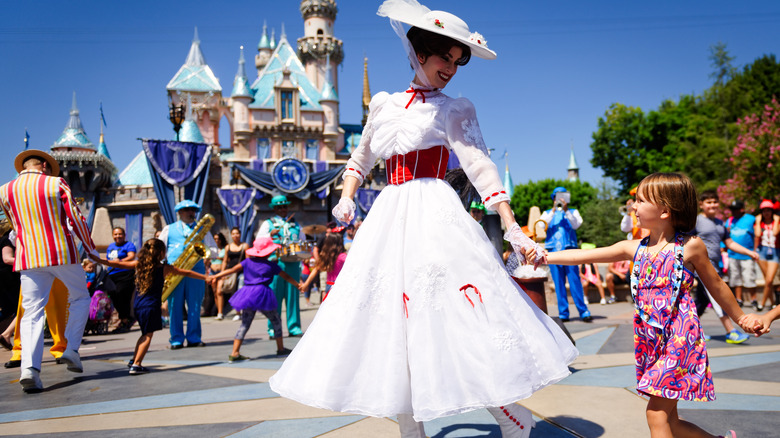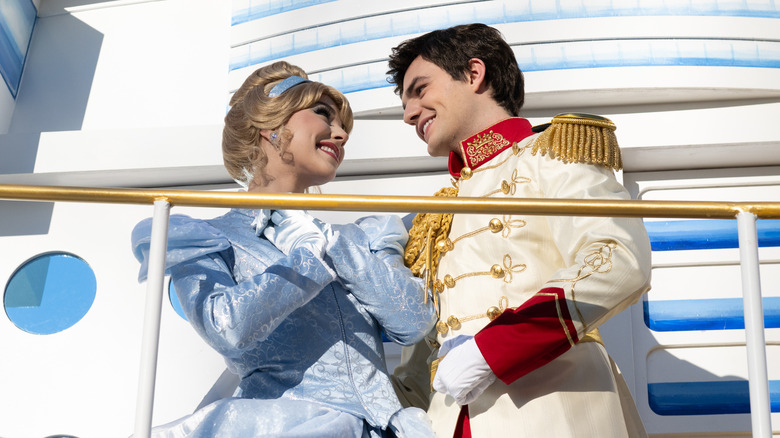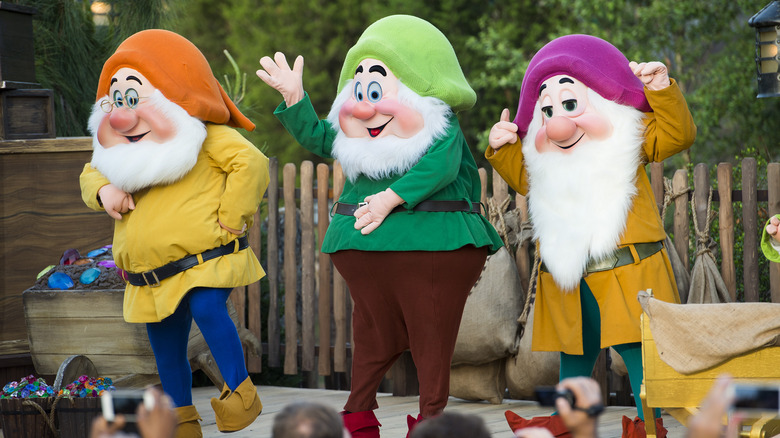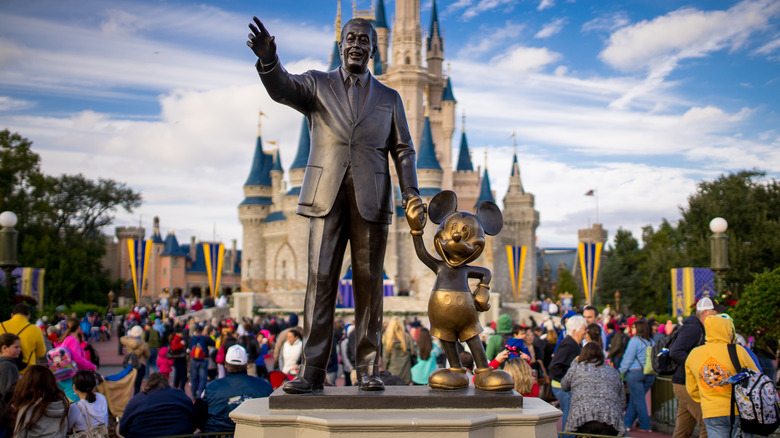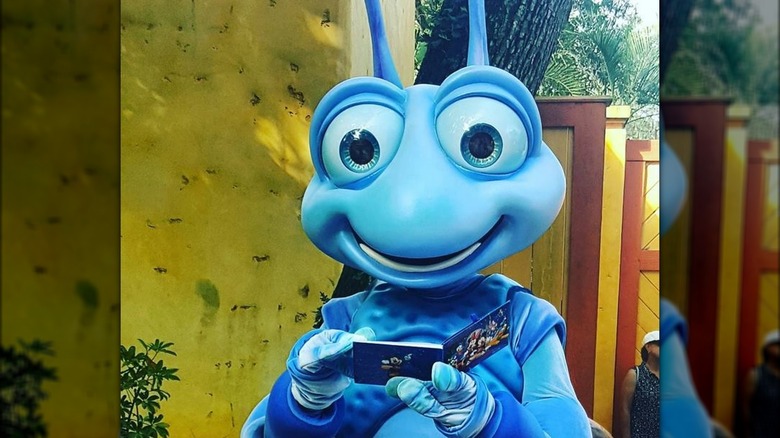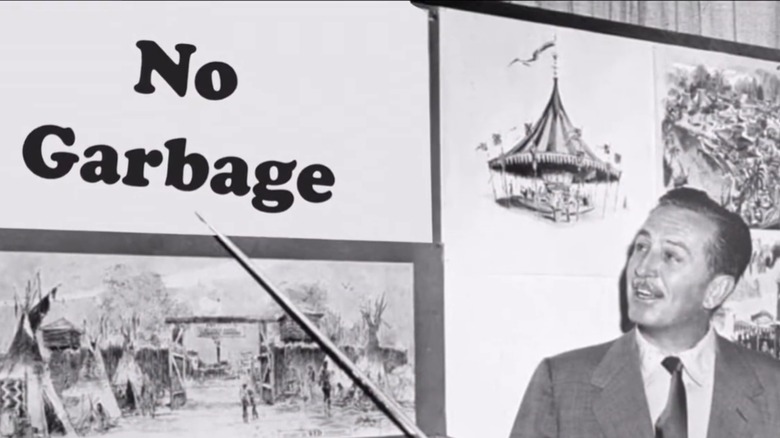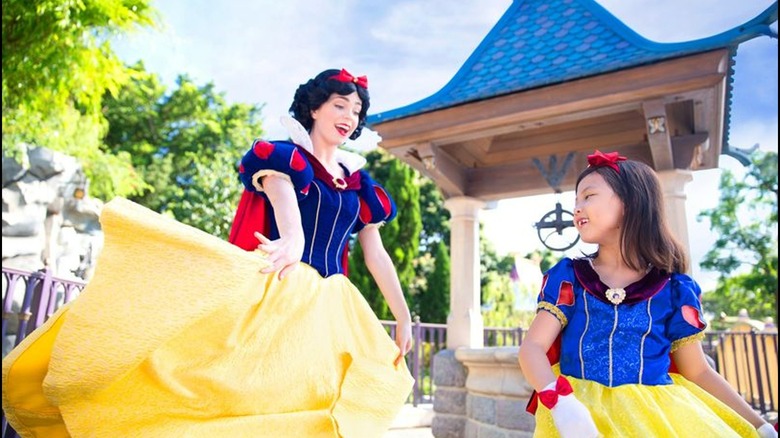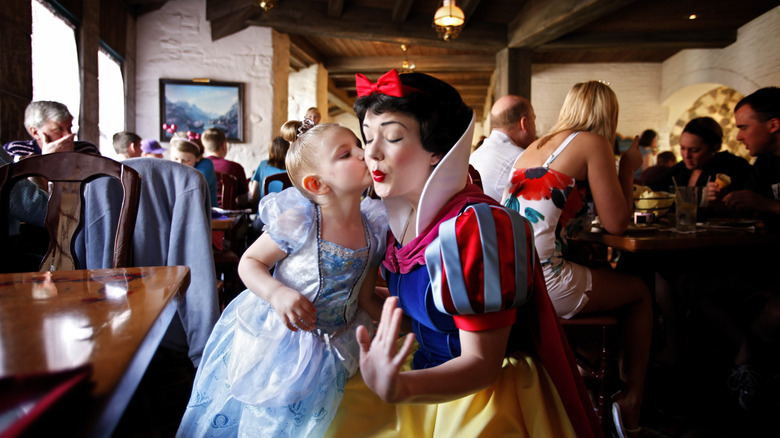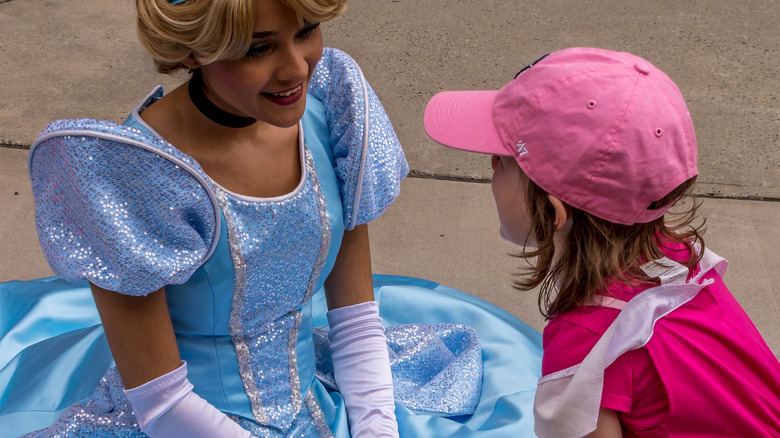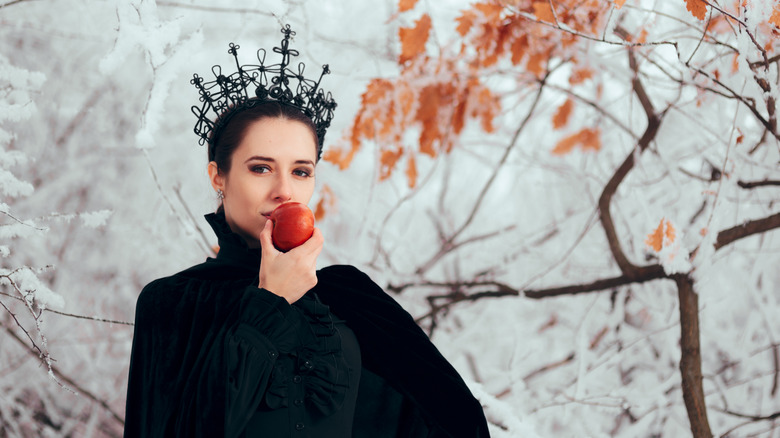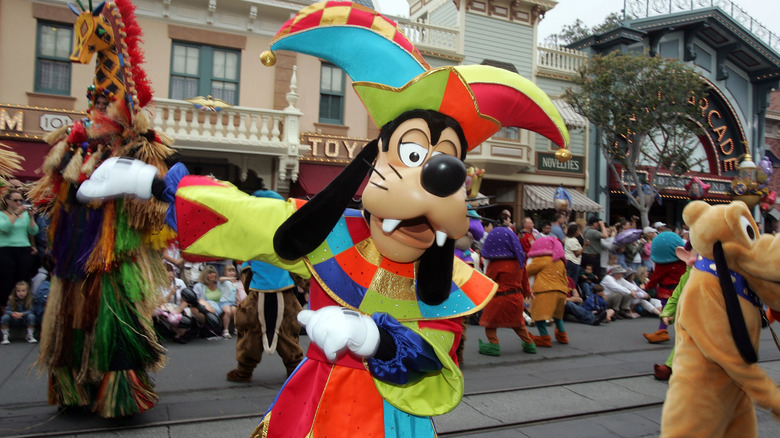The Most Bizarre Rules Disney Park Character Performers Have To Follow
Spending a day in one of the many Disney parks around the world is often a magical experience. Disney Cast Members, as they're known, are hard at work every day creating that experience for guests both young and old (adults, too, can find great joy in Disney parks). Unlike some other theme parks that focus on rollercoasters and other excitement-driven rides (home to the likes of the longest coaster tracks or the best thrill ride experiences), the core Disney experience is all about the joys of youthful exuberance. This atmosphere is developed through the use of Disney characters, scenery, weird park quirks designed to manage the facilities, and, of course, the Disney stories. And yes, there are rollercoasters and thrill rides, including some new ones coming to Disney parks in 2024.
One of the most iconic scenes you'll come across when visiting a Disney theme park is a character come to life. An integral part of the Cast Member ranks is the character actors who bring these visions to the park experience. Considerable research goes into these roles, and Disney has spent a great deal of time honing its hiring and training practices, too. The results are an immaculate park experience that allows children and adults to meet their favorite characters from the silver screen in person. Yet, with all that goes into these portrayals, there are some unique strings attached for Cast Members. Many interesting and perhaps even head-scratching rules govern their performances and employment relationship more broadly.
Disney cast members are never out of character
One thing that sets character actors apart from nearly any other employee at a theme park is the expectation that these individuals protect the reputation of the Disney company and the image of the characters in their orbit. This includes both time spent on the job and off the clock. Indeed, working as a Disney character performer is seemingly a 24-hour gig! While there are no details on how or if Disney might check in on performers outside their in-park contributions, expectations include responsible drinking practices when out and about, refraining from cursing and other vulgarities and crude language, and common sense social media usage.
Another common rule in this realm is the entrance requirements of Cast Members when they aren't working. Employees enjoy free access to the parks when they aren't on the clock — a major perk for Cast Members — but they can't use the employee parking lot and have to scan in through the front entrance gates, just like any other visitor. However, the New York Post reported in 2022 that actors have been terminated after videos of their in-park performances were uploaded to social media. It would appear that some kind of quality control measures may be in place to ensure that characters aren't breaking rules or acting out of character, especially when being filmed by visitors.
Character performers must wear many hats
A Disney character actor might train for a few select roles, but nearly any additional character might come calling at a moment's notice. For one thing, auditions for these roles cover all Disney characters that might appear in the parks, with only "male-" and "female-presenting" clarifications to put any sort of finer point on what Disney is seeking. There are no specialists here.
When taking on the role of a princess, for example, it's common for Cast Members to train for another performance role in a fur character. This means that face character performers will typically tackle two separate performance roles on a regular basis, but stand-in duties might see a Cast Member donning the equipment to bring a totally different Disney personality to life for the day. Performers will need to constantly remain on their toes and ready to step up in a range of different responsibilities should the need arise. A Cast Member calling in sick or a conflicting schedule might require someone to wing it in a performance they aren't normally tasked with, or in a different park than they typically spend their days — Magic Kingdom versus Epcot, for instance in Orlando.
Employees never point with just one finger
A completely visible rule that Cast Members and character performers specifically must always follow involves the "Disney point." Everyone points at things from time to time; whether it's done as a way to give directions or when asking a bartender for a specific drink in a loud environment, pointing helps clear up potential miscommunication. However, the act of pointing can create a brand new miscue in conversation under the right circumstances. Namely, Walt Disney noted that visitors to his parks came from all over the world, with some hailing from cultures where pointing can come across as rude or insulting. Every culture has its own way of indicating a thing off in the distance, and the one-finger point isn't always that solution.
As a result, Disney parks began instituting the two-finger point. This aversion to single-digit pointing is trained into new Cast Members, and visitors to Disney parks will often see full hand points, both arms thrust out in a direction, or the classic, two-finger point. This technique allows performers to be helpful to guests who might need assistance in finding a specific attraction while also conveniently avoiding any potentially friction-filled cross-cultural miscommunication.
They are taught their own autograph
A theme among Cast Member rules centers on the suspension of reality. When guests enter a Disney park, they are stepping through a sort of metaphorical portal, leaving the real world behind and engaging with a Disney-fied universe. Everything here fits into the mold of the Disney aesthetic, including the character performers. When guests meet a character in a Disney park, they aren't engaging with an individual in costume, but rather the real deal. Whether it be Pluto, Aladdin, or Belle, everything about the character must be spot on because this is the actual individual, not a look-alike or copycat. This includes the autograph left behind in a visitor's book. As a young child visiting Disney World parks in Orlando, I can distinctly remember carting around an autograph book and searching for characters to interact with and get autographs from.
Producing a uniform signature is a central part of the role, considering that a character actor isn't portraying the personality but becoming them, and taking on their way of signing, too. In order to maintain the continuity of a character from one day to the next, Cast Members must memorize the font style and writing method required to produce a character's unique signature. They are trained meticulously to make both physical mannerisms and character quirks, as well as the way any given Disney character writes.
Cast members must 'swoop and scoop' garbage off the ground
No Cast Member is immune to the duty of cleanliness that Disney parks are known for. The parks try to cast the vision of a utopian paradise where nothing should be out of place, and garbage should never be seen by guests — Walt Disney famously decreed that no guest should be more than 30 steps from a trash can in a Disney park. Cast Members must routinely empty garbage cans around the park and pick up any stray trash found on the ground. Even Disney princesses are on the lookout for trash that hasn't been properly disposed of.
Cast Members don't just reach down and grab junk they might find. Instead, cleaning up the park must conform to a character's overarching personality. The general practice for Cast Members (from character attendants who help protect character actors from the shadier side of the job to ride operators and beyond) is to "swoop and scoop" the trash and then casually drop it in a can while walking past it. This is done specifically to preserve the visual aesthetics of the environment. Rather than bending down like a typical person might, this two-phase trash disposal method more closely resembles how a person in a cartoon or Disney movie might gracefully move while performing the action. The result is a clean park that doesn't rely on mannerisms that would be found out in the real world beyond its entrance gates.
The Disney look has changed, but remains stringently enforced
Standards have changed throughout the years, especially since the 1950s when Disneyland was opened. However, some features hold to this day. Piercings were outlawed entirely for all Cast Members, as were tattoos. Hair styles were also strictly maintained. Today, Princesses still can't show off ink, and Cast Members across the board are barred from getting too many piercings. Their tattoos must also conform to certain standards in terms of size, location, and style.
These kinds of personal image standards remain in place to keep characters uniform across actors and in line with the aesthetic of the characters themselves. Disney standards initially mandated that Cast Members look "clean, polished, and approachable," a theme that remains in place today. But the way that manifests itself has shifted alongside our social and societal sensibilities for many of the Cast Members outside the ranks of character actors.
Character performers don't hold babies
One of the rules that character performers follow stringently has nothing to do with internal guidelines on etiquette or atmosphere. Rather, the prohibition on holding babies is a safety measure that protects everyone involved. It's less of an issue for face characters who often have their hands, arms, and eyes unobstructed, but fur characters are typically hindered tremendously in their ability to assess their surroundings. As a result, it can be dangerous to take a baby from an eager parent. Without free hands and the ability to look around without a mast blocking out some of the environment, a fur character, in particular, could easily drop a baby accidentally. Because of this safety hazard, Disney character performers will stringently refuse to take a baby from anyone.
Performers note that breakthrough incidents can happen, however. A pushy parent might succeed in dropping their child into the arms of a character actor if the timing works out perfectly or the character is distracted. If a breakdown in this rule does occur, the handler is often able to quickly diffuse the situation, but character actors will kneel down to get the baby as close to the ground as possible. This mitigates the risk of a fall without forcing the character to break the magic.
Disney princesses never stop a hug first
Well-documented on social media, the Disney method of hugging is one of the most wholesome rules of the bunch. It's perhaps not something most people might think of on their own, but once you notice it in practice, you can't unsee the underlying principle. Disney princesses — and presumably other characters, too — won't end a hug before the child they're embracing does. This has led to some funny social media posts showcasing lengthy princess hugs with children refusing to let go for a very long time.
One HuffPost contributor noted in 2015 that she gave her own child a hug like this one nondescript weekday morning, and it taught her "to savor the moment, to greet the affection, and to know that to that child, holding on can make all the difference." This practice warms the heart, and it's designed to make a day spent at a Disney park all that more magical for children who are often in awe when meeting the characters they've only ever seen on the screen.
Villains can never kneel or sit
Generally speaking, most characters are allowed wide leeway on movements and mannerisms — as long as they conform to their character's personality, of course. Princesses and fur characters can sit down or crouch to take pictures with guests, but Disney villains must play by a different set of rules. For one thing, many character outfits prevent a Cast Member from performing certain kinds of movements. For instance, Lady Tremaine from "Cinderella" is outfitted with a hip cage that makes sitting or kneeling particularly difficult from a physical perspective. Even so, villains must maintain the atmosphere that their character brings to the table.
This means that villains are typically sneering, quasi-belligerent antagonists. Most Disney villains fit a similar mold that sees them looking down on other characters in their respective movies. Whether it's Ursula's power-hungry designs on ruling the sea or Gaston's self-importance and vain desires, every major villain from across Disney franchises thinks of themselves as superior in one way or another. The result is a real-life example that must conform to this idea; one way that Disney achieves it is through a physical prohibition on sitting, squatting, or kneeling. If the characters remain standing, they are physically above the people they're interacting with. It's a subtle nod to the psychology of these characters within the Disney universe.
Some days, an actor will stand on call as a spare
Character actors are typically assigned a main role and a secondary character to perfect. These roles are their main duty, and they will spend the majority of their time focusing on bringing these personalities to life (through research and physical practice of the characters' movements and behaviors). Beyond this, however, a Cast Member may be called on as a spare from time to time. Spares are there to take over if another character performer is hurt, gets sick, or isn't available to start or finish their shift for any other reason.
Spares can find themselves in any number of unique character roles. The possibilities are truly endless. This creates a bit of a natural divide among Cast Members, of course. Some character actors thrive on the variety that these shifts create, while others dread the thought of having to step into a role they may not be completely comfortable with at a moment's notice. However, a shift as a spare can ultimately bring about a relaxing day at the park. Some spares spend much or all of their days waiting to be called on, only to continue waiting in the wings. On these slower days, spares are able to hang out with their colleagues and chat, play games, or just take a load off — a definite perk of the gig!
Cast members don't play characters, but are rather 'friends' of theirs
Maintaining the ambiance of a Disney park requires a bit of a mentality shift for visitors and the staff members who help create the environment. This means that Cast Members are required to speak in a sort of code when discussing their role, as well as in their daily tasks. There's even a secret language they use to communicate issues with one another. "Signal 25" indicates an emergency involving fire, while "Code V" lets other Cast Members know that a guest has ralphed.
More directly, however, the language a Cast Member uses to discuss their daily activities must conform to the Disney standard, even outside the office. Rather than saying they "played" a character, Cast Members are "friends" of the characters they inhabit. This mindset is in place to promote the magical world of Disney theme parks as a comprehensive idea. Being friends with the characters implies a realness that portrayal eradicates. As a result, the language used to talk about daily life as a character actor must conform to the same standards as the in-park activities that an actor engages in.
Character performers must always protect the magic
It's been alluded to throughout this list of character rules, but perhaps the most important task that Cast Members in these roles must always prioritize is the art of "protecting the magic." Disney parks are a portal into a uniquely creative and adventure-filled world. The aura of the theme park isn't crafted as a stylized space that's just like Disney movie sets — they are meant to actually be the environments that children marvel at on the screen. Character performers must, therefore, become the personalities of their "friends."
For instance, a Merida met in Disney World won't only be dressed as she is in the movie, but she will also sound Scottish. More interestingly, though, characters will only understand things that exist in their universe. So, if you begin discussing your wireless provider or talking about astronauts, the 10th-century Scottish princess is likely to cast a puzzled look on her face. She might even joke with you about not knowing what those things are; after all, these don't exist in her world. This leads to another takeaway that visitors should consider for themselves. It can become quite awkward for everyone involved if guests start talking about "non-existent" things with characters just to create a reaction. This should be avoided, particularly around young children, in the same way that conversations about Santa Claus can toe dangerously close to the line of breaking the glass.
